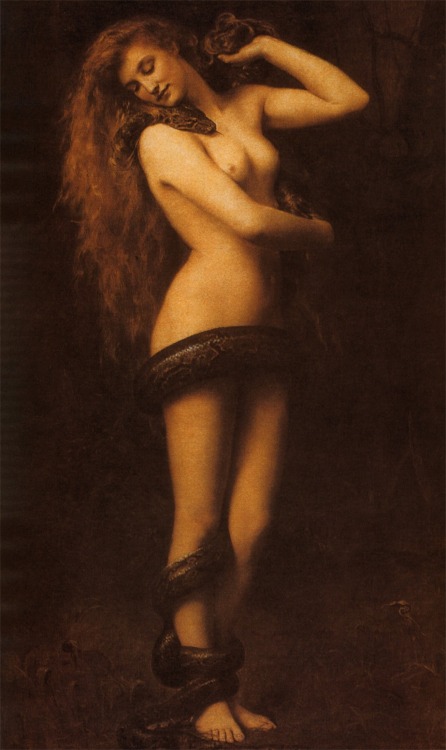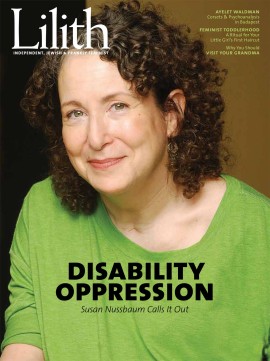Whether it is as the vampire "Goddess" (it's complicated) from True Blood or the first of all demons from Supernatural, the name Lilith has pervaded popular culture, especially the fantasy genre. Consistently, she is viewed as an "evil" character, as a corrupted being who seeks to tempt and lure protagonists into danger or perform some other great act of evil. Marvel adopted her not once, but twice, as the eldest daughter of Dracula and as the mother of all demons. In even more contemporary and young adult popular culture, there is a demon in Cassandra Clare's Moral Instruments named Lilith.
Whenever a character appears in a book, a show or a game with this name, you know that they are going to turn out to be more than they might initially appear (take for example Lilith as she appears in Fable II or as she appears in something as far removed from Fantasy as Frasier) and you know that, more often than not, she will turn out to be your foe. Characters named Lilith are always female, always rebellious and almost always in possession of some dark power or part of some unholy hierarchy.
 |
| Image posted by Sadisticupid |
But who exactly is this figure of Lilith? Where does she come from?
The short answer is that Lilith appears as a highly mysterious and somewhat prolific figure in the Jewish mythologies of Assyria and Babylonia. Mentions of her are widespread and, as with many ancient figures, she seems to have a huge number of different incarnations According to most accounts, Lilith is a demon or somehow linked to demonic or dark forces. Often, she is associated with childbirth, as a negative influence who seeks to steal and devour children, or as a temptress who seduces and ultimately destroys men, thus preventing them from having children with mortal women.
According to some sources, once a child was born in a Jewish family, they would be given an amulet to wear, which would have been spelled in order to protect them from Lilith. This was often worn until the child was circumcised, at which point they were seen as protected by God through the Jewish Covenant.
So, from this reading, we have an evil, monstrous figure indeed, one which deserves the legacy she has received: appearing throughout our culture as a seductress and corrupter, as a demon, a devil or a witch. And yet, this is not the only reading of the figure of Lilith, there is another...
 |
| Painting by John Collier |
According to this second reading of Lilith, the earliest evidence of which is to be found in the Alphabet of Sirach, Lilith is no demon. In fact, she is the wife of Adam, as in Adam and Eve. Furthermore, she is Adam's first wife and, unlike Eve, she was not created from Adam's rib after he was created, but at the same time as him and from the "earth". Naturally, having been made from the same stuff as her husband, Lilith considered herself, and rightly so, Adam's equal and therefore she refused to submit to him. Thus, according to the legend, she leaves him and the Garden of Eden forever, refusing to return and somehow ends up mating with the archangel Samael (in religious texts, these things just seem to happen).
We can read Lilith as a female version of Lucifer, though I would argue that the crimes of Lucifer are far greater than those of Lilith. True, both are defying what is seen as the will of God, a complex concept to be sure, but whereas Lilith is asserting that she is equal to Adam, Lucifer asserted himself as the equal to God. Hence, Lucifer is punished with damnation, whereas the story as to what happens to Lilith after her "rebellion" becomes immediately unclear.
So, the question I shall ask is this: if we are to read the story of Lilith in this second way, why does our culture continue to connect her name with evil and corruption?
If Lilith's only crime is that she, as a woman, wanted to be equal with Adam, representative of man, what is so evil about it? I think that we can find an answer within traditional, particularly religious, attitudes to gender and sexuality, attitudes which our culture, in spite of numerous assertions to the contrary, have still failed to entirely shake.
The rebellion of Lilith against Adam can be easily read as the threatening of masculine power by the feminine. She disobeys him, refuses to submit to him. This is her original crime and it is this transgression that has led to her demonisation. By refusing to obey her husband and perhaps because she is depicted as copulating with an Archangel, she is consider a tempter and a corrupter. True, Samael is not considered entirely innocent, but the majority of the blame is placed on Lilith, for she is the anomaly: a rebellious woman.
 |
| Image posted by Caligo Chaos Reigns |
If we harken back to the two traditional roles given to women within literature, we can see more easily how she is so easily likened to demons, devils and the like. According to a traditional attitude towards literary woman, one which is, thankfully, heavily outdated yet, unfortunately, still relevant today, women fit into the category of the Lady or the Whore. Ladies are noble, delicate, subservient the ultimate example of what woman should be according to traditional gender roles. They are significantly desexualised in that they do not participate in such activity, certainly outside of the marital bed, but this only serves to make them more desirable to the male characters around them. Whores, however, are seen as the complete antithesis to the traditional role of women. They are disobedient to or outside of, or at least on the fringes of, the patriarchal structure, and sexually free. This leads to the corruption of their image, the corruption of Lilith's image.
We can see, with no shortage of clarity, how the traditional has influenced modern representations of Lilith. Whilst she is, undoubtedly, shown as a tempter, she is almost always cast in traditionally female roles. In Supernatural, Lilith is the first demon, making her effectively the mother of all demons as well as the bride or daughter of Lucifer. The Lilith of True Blood is the mother of vampires and the bride of God. Modern representations of Lilith within fantasy all seem to buy into this conception of her as a demon and temptress, but also as a traditional woman.
What I am saying, then, is that, whilst I have no problem with the name of Lilith being used for demonic and seductive characters (I still think that such representations can be interesting, original and entertaining) I do think that her namesake can be used for a lot more. Yes, Lilith has diabolic connotations and those can be interesting to explore. But still, this alternative interpretation of her character and what she means within Jewish mythology means that characters named for her should not be eternally limited to the role of the harbinger of darkness and desire.
Interestingly enough, her namesake has been used in one manner, though not in the form of a character. There exists a feminist, Jewish magazine which uses her namesake to convey their message of respect for woman, their desire for equality as well as reconciliation with Judaism. Lilith is a name with many connotations and much potential and it should not be confined to the demonic.
 |
| Cover of the latest issue of Lilith |
No comments:
Post a Comment